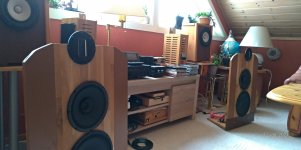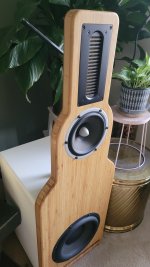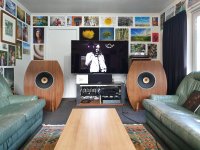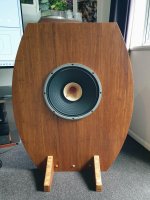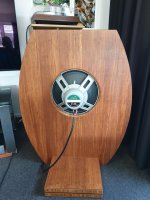@hollowboy:
I didn't see what kind of frequency resolution your measurements achieved. This can make narrow features "disappear", especially at lower frequencies. Do you know what that is for your data?
Also, did you remove the rear felt? I think I removed it, and it might provide a little damping around resonance.
It's possible that perching the driver on top of something changes the response around 1kHz since that "baffles" part of the output. I think I still have the drivers, so I could try to remeasure them.
I didn't see what kind of frequency resolution your measurements achieved. This can make narrow features "disappear", especially at lower frequencies. Do you know what that is for your data?
Also, did you remove the rear felt? I think I removed it, and it might provide a little damping around resonance.
It's possible that perching the driver on top of something changes the response around 1kHz since that "baffles" part of the output. I think I still have the drivers, so I could try to remeasure them.
Hi there.
Here is my solution on the AMT as super tweeter. I use the Aurum Cantus AST2560 Aero Striction Tweeter from around 6000 Hz. Just with a capacitor for crossover. I tried it first from 9000 Hz, but wanted more from this super tweeter. The Betsy is run Fullrange. I mounted the Aurum where the old B&G Neo3 was (the Neo3 was too sharp and raw for my ears). Now there is a complete new and beautiful treble with a lifelike sound. My SIT mono poweramplifier is perfect for this task, and the Luminaria preamp is also nice (also a SIT-transistor).
Best from Olav
Here is my solution on the AMT as super tweeter. I use the Aurum Cantus AST2560 Aero Striction Tweeter from around 6000 Hz. Just with a capacitor for crossover. I tried it first from 9000 Hz, but wanted more from this super tweeter. The Betsy is run Fullrange. I mounted the Aurum where the old B&G Neo3 was (the Neo3 was too sharp and raw for my ears). Now there is a complete new and beautiful treble with a lifelike sound. My SIT mono poweramplifier is perfect for this task, and the Luminaria preamp is also nice (also a SIT-transistor).
Best from Olav
Attachments
Number 7 is then at 35cm distance horizontal, and 30 cm off axis vertically? I.e. almodt at 45 degrees offset?
(7) was at 1m horizontal distance, same as (6)
@hollowboy:
I didn't see what kind of frequency resolution your measurements achieved.
I don't understand measurement tech well enough to answer this.
The first 3 plots were REW defaults, no smoothing or anything. So whatever resolution the default is.
The last 4 plots were both windowed (2ms) and smoothed (1/24).
Nodid you remove the rear felt?
It's possible that perching the driver on top of something changes the response around 1kHz since that "baffles" part of the output. I think I still have the drivers, so I could try to remeasure them.
They were were more than 10cm from a solid surface.
A remeasure would be interesting. Maybe check both drivers - maybe one of your was dropped, or something.
Another artifact I noted in tests (other than the one I noted from bad gain structure) is that when adding a highpass cap, I got high distortion (similar to your 7kHz peak). When I played music through it for a minute, then measured again, I got much lower distortion.
I use the Aurum Cantus AST2560 Aero Striction Tweeter from around 6000 Hz.
Looks good - a short ribbon like this seems to be a much simpler solution if you want just HF.
The PRO4 is more of a wide band. Heavier / more robust diaphragm, radiating area is roughly triple, so it can be crossed lower.
However, the height of diaphragm makes the vertical dispersion hard to live with.
So far, the best solution I've tried is to mask part of the front of the PRO4 (just by covering 2 of the corners, maybe 25% of the surface area, with tape).
This takes the lumps out of the off-axis measurements / gets the vertical dispersion to behave more like a normal tweeter.
Sensitivity above 1500Hz is reduced by about 2dB.
Member
Joined 2003
I assume this flaw / feature would be ~the same for any planer driver of these dimensions.
Yes, absolutely right. Any driver of similar dimension will have the same limitations. You will find that the horizontal axis is very wide with this one. It can and does still sound great, but recommend use in a large room so you can sit back a good 3m. Leave some of the on-axis lift when you use it, don't flatten out that response completely or you'll loose all the life. One benefit from the vertical directivity is that there is little reflection from floor and ceiling, this was observed when I measured, I could set the gate a lot larger than I normally would.
It's a great tweeter in my opinion, but doesn't have the "sparkle" or "air" that you may be used to in the top end with small dome tweeters. The lower treble 2-7kHz is just superb though IMO. If you still have good ears and want that very top octave performance, then you'll need to use another tweeter.
FWIW I have good measurement attached of my AMTPRO-4 in dipole configuration, measured as mounted in the photo. I crossed at 1.5kHz.
Attachments
OK.(7) was at 1m horizontal distance, same as (6)
30cm up at 1m distance is about 18 degrees. This tweeter is a ~7 inch vertical, so it will hava considerable vertical beaming. As will any other ribbon or AMT of the same height.
In other words you need to aim precicely to hit ear height at the listening position.
The need for a head clamp will lessen with distance, though.
I have a Beyma TPL75, which has a smaller diaphragm. I can measure the same effect to a much smaller degree, but it doesn’t really bother me that much. I tweak the dsp to a bit of slope in the response anyway.
Johan-Kr
Tweeter for Betsy open baffles
Hi Olav - I have built some Big Betsy open baffles (photos attached) using the Lii Audio F15 full-range driver and would like to try adding a tweeter. Would it matter that the F15 driver is 8ohm and the Aurum Cantus AST2560 Aero Striction Tweeter is only 4 ohm? (I am powering them with a Willsenton R8 tube amp). What capacitor are you using for 6k crossover?
Cheers
Steve
Hi there.
Here is my solution on the AMT as super tweeter. I use the Aurum Cantus AST2560 Aero Striction Tweeter from around 6000 Hz. Just with a capacitor for crossover. I tried it first from 9000 Hz, but wanted more from this super tweeter. The Betsy is run Fullrange.
Best from Olav
Hi Olav - I have built some Big Betsy open baffles (photos attached) using the Lii Audio F15 full-range driver and would like to try adding a tweeter. Would it matter that the F15 driver is 8ohm and the Aurum Cantus AST2560 Aero Striction Tweeter is only 4 ohm? (I am powering them with a Willsenton R8 tube amp). What capacitor are you using for 6k crossover?
Cheers
Steve
Attachments
Sorry 4 late respons
Hi Steve.
I forgot to answer your question about my tweeter(Aurum Cantus AST2560 - 4 ohm). But I can now give my take on the implementation with these together with the Betsy (ca 8 ohm) and the Eminence 12``. My amplifier is around 2 x 8 watt (homemade SIT). The Aurum Cantus is connected I connected first with 4,7 microFarad Audun-Cap. This gives ca 9000 Hz crossover point. But later I connected in paralell 1 2,2 microFarad Audiophiler. This lower the point to a little below 6000 Hz. And everything is beautyfully driven from my Amplifier. And the result is so smooth and revealing - with a lifelike display on good recordings. The Betsy was good alone, but this update raised the sound several degrees.
So with your setup I would start with ca 7-8000 Hz on and try that with a good tweeter. The Lii15 is ca 97 db SPl so try a f.eks AMT with more than 95 db SPl.
Best from Olav
Hi Steve.
I forgot to answer your question about my tweeter(Aurum Cantus AST2560 - 4 ohm). But I can now give my take on the implementation with these together with the Betsy (ca 8 ohm) and the Eminence 12``. My amplifier is around 2 x 8 watt (homemade SIT). The Aurum Cantus is connected I connected first with 4,7 microFarad Audun-Cap. This gives ca 9000 Hz crossover point. But later I connected in paralell 1 2,2 microFarad Audiophiler. This lower the point to a little below 6000 Hz. And everything is beautyfully driven from my Amplifier. And the result is so smooth and revealing - with a lifelike display on good recordings. The Betsy was good alone, but this update raised the sound several degrees.
So with your setup I would start with ca 7-8000 Hz on and try that with a good tweeter. The Lii15 is ca 97 db SPl so try a f.eks AMT with more than 95 db SPl.
Best from Olav
I have been pondering driver resonance vis a vis passband for subs. But it is also a great issue for tweeters. While the resonance is never in the passband for tweeters (they might self-destruct) conventional passive crossovers will be putting demands on the tweeters for an octave below the XO frequency. For many tweeters, that still has them struggling to play into you room in the vicinity of their resonance.
As an enthusiast for DSP, you can guess my solution is going to 48dB/8ave XO. Makes tuning a system much easier if the mid and tweeter drivers are playing only within their happy passband.
Before committing to a high freq super-tweeter, a builder should see what they can detect up there. My DSP has nice little lamps that reveal how much content is sent to each driver and a little button I can press to mute the tweeters (or with a helper, do it blind - or press button an irregular number of times to fool yourself).
Quite little sound north of 3 kHz, even with 48 db slope for the mids. Not too hard to detect at 3kHz XO, of course, but at 4 or 5 and certainly at 6kHz, might not know the tweeter is connected or may need a certain favourite music with a triangle to barely hear it. If you are brave, try it before you scoff.
B.
As an enthusiast for DSP, you can guess my solution is going to 48dB/8ave XO. Makes tuning a system much easier if the mid and tweeter drivers are playing only within their happy passband.
Before committing to a high freq super-tweeter, a builder should see what they can detect up there. My DSP has nice little lamps that reveal how much content is sent to each driver and a little button I can press to mute the tweeters (or with a helper, do it blind - or press button an irregular number of times to fool yourself).
Quite little sound north of 3 kHz, even with 48 db slope for the mids. Not too hard to detect at 3kHz XO, of course, but at 4 or 5 and certainly at 6kHz, might not know the tweeter is connected or may need a certain favourite music with a triangle to barely hear it. If you are brave, try it before you scoff.
B.
Last edited:
Thanks Bentoronto - I think you were responding to me? I have a Deqx DSP/DAC which I use mainly for crossover and time delay correction for the Lii full-range driver and the subs. I could also use it for a crossover to the tweeter at from 48 to 300 db/octave, either linear phase, LinkwitzRiley or Butterworth, if that's any help?
Steviewunda -
If you have a DSP, you are ready to go (after getting a cheap amp at the Salvation Army store for tweeters - all amps sound identical).
Start with REW with mic at your chair and giving each driver a wide-range signal (not too loud for tweeter, of course). That helps choose passbands when you see what drivers handle well in FR and distortion.
Go with 48 dB/8ave slope, any theory/concept. Differences are inaudible.
Run the system and EQ any major deficiencies.
B.
If you have a DSP, you are ready to go (after getting a cheap amp at the Salvation Army store for tweeters - all amps sound identical).
Start with REW with mic at your chair and giving each driver a wide-range signal (not too loud for tweeter, of course). That helps choose passbands when you see what drivers handle well in FR and distortion.
Go with 48 dB/8ave slope, any theory/concept. Differences are inaudible.
Run the system and EQ any major deficiencies.
B.
Update time - I've tried the tweeter in several configurations - using the Deqx as active crossover and powering the tweeters with either the Tripath or Yamaha amp, at crossover frequencies of 2.5khz, 6khz, 10khz, and 12khz. I've tried with and without Deqx calibration, and with and without DSP correction. I've also tried using a resistor & capacitor crossover (@ 12400hz) - both via the Deqx, and directly through the tube amp without the Deqx. I've also tried using just the full-range driver on its own, both via the Deqx and directly through the amp.
My preferred configuration so far is to just use the full-range drivers without the tweeters, via the Deqx, using the Deqx's calibration & correction, crossover, group delay, and DSP capabilities. The tweeters detract from the coherence of the image and soundstage, and of course I was hoping for the opposite. And I'm not detecting any lack of highs, harmonics, etc without the tweeters in play.
I won't make a final decision until I hear back from my UK Deqx guru, who has my Deqx speaker measurement files to fine-tune. If he works some magic with the measurements that included the tweeters and comes up with a sound that I prefer to full-range only - well and good, I'll go with that. If not, I'll stick with the tweeterless OB's - which are sounding really good just with my inexpert Deqx corrections. And I'll have some tweeters and amps to sell ;-)
My preferred configuration so far is to just use the full-range drivers without the tweeters, via the Deqx, using the Deqx's calibration & correction, crossover, group delay, and DSP capabilities. The tweeters detract from the coherence of the image and soundstage, and of course I was hoping for the opposite. And I'm not detecting any lack of highs, harmonics, etc without the tweeters in play.
I won't make a final decision until I hear back from my UK Deqx guru, who has my Deqx speaker measurement files to fine-tune. If he works some magic with the measurements that included the tweeters and comes up with a sound that I prefer to full-range only - well and good, I'll go with that. If not, I'll stick with the tweeterless OB's - which are sounding really good just with my inexpert Deqx corrections. And I'll have some tweeters and amps to sell ;-)
Which would you prefer? They were all made with Deqx's proprietary software - if you have that I could just supply the .mzd file and you could view everything - original driver measurements, correction filters, corrected measurements, room measurements. I'm not sure that you can access the the Deqx software without a serial no. I'll check. Otherwise I could supply screenshots of some of the measurements of most interest?
Last edited:
- Home
- Loudspeakers
- Planars & Exotics
- Dayton AMTPRO-4: how low to cross when used open back?
